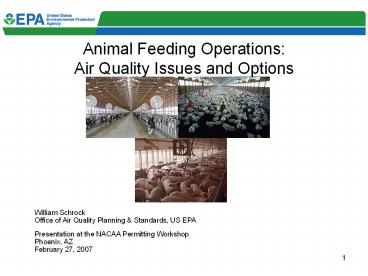Animal Feeding Operations: Air Quality Issues and Options PowerPoint PPT Presentation
Title: Animal Feeding Operations: Air Quality Issues and Options
1
Animal Feeding Operations Air Quality Issues
and Options
William Schrock Office of Air Quality Planning
Standards, US EPA Presentation at the NACAA
Permitting Workshop Phoenix, AZ February 27,
2007
2
Overview
- Introduction
- National Air Emissions Monitoring Study
- Short-term Goals for EPA
3
Landscape
- Animals being concentrated
- Public air quality complaints abundant
- Lawsuits increasing against farms
- CAA applicability confusing
- Political fallout likely for either inaction or
heavy-handed control
4
Agreement Overview
- EPA USDA asked National Academy of Science
(NAS) to conduct the AFO air emissions study - NAS study conclusions
- No reliable emission factors for AFO exist
- Additional data needed to develop estimating
methodologies - Current methods for estimating emissions not
appropriate - Use process-based approach
- Consent agreement developed in response to
- Public concerns
- NAS report
- Consent agreement developed by
- EPA
- Industry representatives
- Proposed agreement coordinated with
- Agricultural industry representatives
- State local government officials
- Environmental organizations
- Citizen groups
5
Agreement Overview (cont)
- What is the Agreement? Voluntary consent
agreement open to contract growers and
integrators. Industry agrees to pay to conduct
emissions testing. Targeted AFO sectors - Swine
- Poultry
- Layers
- Broilers
- Turkey
- Dairy
- Federal Register Notices
- Signed on Jan. 21, 2005
- Published on Jan. 31, 2005 (70 FR 4958)
- Initial public comment period closed on March
2, 2005 - Re-opening comment period from April 1 through
May 2, 2005 - Extending signup period to July 1, 2005
- Information available at
- www.epa.gov/fedrgstr
- www.epa.gov/airlinks/airlinks3.html
- www.epa.gov/compliance/resources/agreements/caa/ca
fo-agr-0501.html
6
Monitoring Study - Signups
- EPA received approximately 2,700 agreements
representing over 13,000 farms.
7
Monitoring Study - Overview
- Purpose gather data for developing emission
estimating methodologies - Funding provided by participating AFO
- Monitor for
- Particulate matter
- Hydrogen sulfide
- Volatile organic compounds
- Ammonia
- Monitoring anticipated to begin in early 2007 and
continue for 2 years - Data made available to the public
8
Monitoring Study Site Selection
- Focuses on three AFO sectors
- Swine
- Poultry
- Dairy
- Types of operations
- Sow, nursery, finisher (swine)
- layers, broilers, hatchery, pullet (poultry)
- Dairy
- Manure Management Techniques
- Liquid system
- Solid system
- Regional representation
- Proximity to potential principal investigators
9
Monitoring Study Site Selection
10
Monitoring Study Work Plan Development
- EPA has approved the monitoring plan sites
- Approved on November 29, 2006
- Plan included
- Quality Assurance Project Plans (1 each for
lagoons and barns) - Standard Operating Procedures (76 unique SOPs
drafted) - 24 monitoring sites approved
- EPA anticipates monitoring will begin in Spring
07
11
Monitoring Study The Challenges
12
Monitoring Study Overcoming The Challenges
- Changing Climatic Conditions
- Regional Representation
- Continuous Monitoring
- Heated Sampling Lines
- Partially Enclosed and Naturally Ventilated
Structures - Numerous Emission Sampling Points
- Multiple meteorological sampling points
- Monitor Mostly Mechanically Ventilated Buildings
- Large Open Sources
- Use Open-Path Measurement Techniques ()
- Monitor on a quarterly basis to keep cost down
- Changing Feed Rations
- Sample Feed
- Continuous Monitoring
- Animal Movements
- Attempt to track animals electronically
- Continuous Monitoring
13
Approach to Naturally Ventilated Partially
Enclosed
14
Approach for Large Open Sources
15
Approach for Large Open Sources
Open-Path FTIR Concept
16
Whats Next?
- Order equipment and assemble monitoring
trailers 6 months - Train staff and mobilize equipment to the field
concurrent w/ above - Begin data collection staggered throughout
Spring 07 - Data collection Spring 07 2 years
- Complete data analysis and publish Emission
Estimating Methodologies 18 months after
completion of data collection - Participants must comply with any applicable
requirements 120 days after publication of
Emission Estimating Methodology
17
Goals for Next 2-3 Years
- Settle issues of CAA requirements
- Emission estimation (e.g., emission factors,
potential to emit) - Source definition
- Applicability cutoff (i.e., size cutoff)
- Fugitive/non-fugitive
- Control technology effectiveness
- Monitoring, reporting and recordkeeping
- Find an Ag-appropriate approach to Title V and
PSD/NSR
18
Goals (cont.)
- Resolve ambient air quality issues
- Provide catalyst for best management practices
(BMP) implementation
19
- Thanks.
- Questions?

